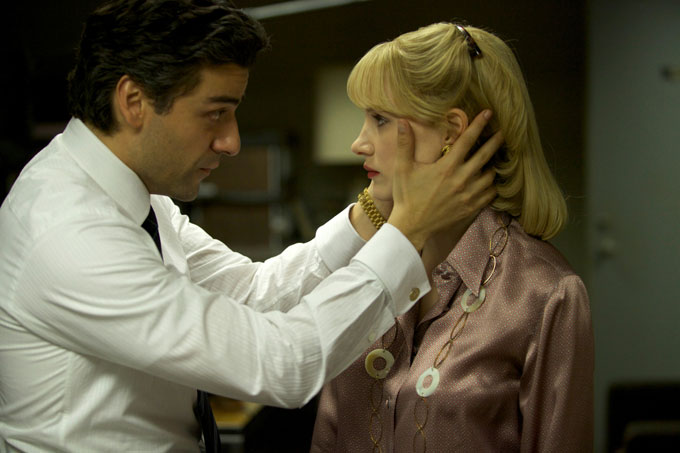Next story: On The Boards Theater Listings
A Most Violent Year
by Jordan Canahai

“1975 was a good year,” so says one of the characters in A Most Violent Year. One can imagine he’s speaking for the filmmaker’s obvious affinity for the movies of that time as much as he is commenting on any action in the story, given how heavily indebted to the American cinema of the 70s the picture is. This 70’s influence is apparent from the opening scene. Scored to Marvin Gaye’s “Inner City Blues,” it follows our main character’s jog from the suburbs of New York to the city’s industrial district and culminates with the armed robbery of one of his company’s heating and gas trucks. The pre-title sequence plays like a cross between Rocky meets Dog Day Afternoon, and promises a much more exciting and interesting film than the one that ultimately follows.
Set in New York City during the winter of 1981, one of the most statistically violent years in the city’s history, J.C. Chandor’s crime drama concerns the seedy business dealings of the biblically named Abel Morales (Oscar Isaac). He came to own a heating and gas business after marrying into the wealthy mob family of his wife, Anna (Jessica Chastain).Their business is a front for illicit activities, a fact known by rival gangsters who have taken to stealing the company’s trucks, much to the dismay of the poor drivers Morales employs. Pressure mounts not just from criminal competition but also from the police officer (David Oyelowo) investigating the Morales’ shady dealings, despite the best efforts of their family lawyer(Albert Brooks) to further expand and legitimize their business.
I’ll give credit to writer/director Chandor where it’s due, much like his central husband and wife couple, he definitely gets points for style. The aesthetic of A Most Violent Year is common to many 21st century films that wear the New Hollywood influence on their sleeves. Bradford Young’s gritty cinematography looks terrific, bringing to mind the work of Sidney Lumet in how eloquently it evokes the urban landscapes of the era-specific New York City. Splattered in graffiti and split along tribal lines, John P. Goldsmith’s production design effectively recreates the Big Apple at a time when it seemed most rotten. Likewise, Alex Ebert’s original score, predominately composed with synthesizers but blended with traditional wind and string instruments, proves a fitting accompaniment. The music appropriately conveys the awkward transition taking place on-screen between the 1970s and 1980s.
With the top-notch production values and the impressive cast one would think A Most Violent Year would end up being a great piece of genre filmmaking. Unfortunately, Chandor’s handling of the material leaves much to be desired. His directorial approach could best be described as “Coppola-lite” in how the relatively young filmmaker attempts to channel Saint Francis, but the end result is more Godfather Part III than Godfather Part II. His sophomoric screenplay does little to invest interest in the audience or set itself apart from other crime films, especially as it limps toward a predictable and clichéd final act. The film’s major set piece is a William Friedkin-inspired foot-chase sequence in which Abel, gun in hand, chases down one of his rival’s henchmen. It’s well staged and edited, but lacks the extraordinary tension and gripping terror of something like the car chase in The French Connection.
Acclaim must go, however, to Isaac for his performance in the lead role. After his sublime work in last year’s Inside Llewyn Davis he continues to prove one of the most magnetic young actors of his generation. Conveying both Abel’s vanity, insecurity, naivety, and desperation all with equal aplomb as him and his wife’s business slips further into chaos, he aptly earns comparisons to Al Pacino as Michael Corleone. Not as impressive, unfortunately, is Chastain as the iron-lady Anna. One of her major scenes involves her mercy shooting a wounded deer as Abel contemplates other ways of putting the animal out of its misery, comes off more silly than shocking. It ranks as one of the more forced moments in a movie chock-full of them.
Like Bennet Miller’s Foxcatcher, which shares many of the same thematic concerns, A Most Violent Year ends up being similarly strained, overly somber, and ultimately dull. While Foxcatcher was so restrained and ambiguous to the point where it was difficult for viewers to muster any empathy, A Most Violent Year is so heavy-handed in its execution and its symbolism that Chandor’s efforts come off as cheap and hackneyed rather than profound and enlightening. His obvious, simplistic depiction of gangster life is especially revealed during the film’s blood-and-oil soaked climax, which leaves one feeling less emotional catharsis than shallow relief. For a much better Coppola-influenced period drama from 2014 that purports to examine the dark heart at the center of the American Dream, I would strongly recommend James Grey’s The Immigrant, starring Joaquin Phoenix and Marion Cotillard. Its Godfather Part II-inspired opening and closing shots alone carry more dramatic weight and emotional resonance than A Most Violent Year does in its entirety.
Watch the trailer for A Most Violent Year
|
Issue Navigation> Issue Index > v14n4 (Week of Thursday, January 29) > A Most Violent Year This Week's Issue • Artvoice Daily • Artvoice TV • Events Calendar • Classifieds |









 Current Issue
Current Issue